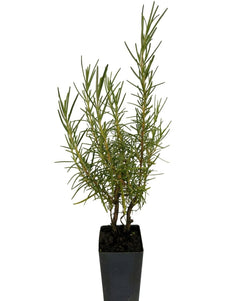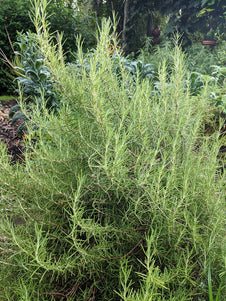





Rosemary - Benendon Blue Rosemary
Rosemary - Benendon Blue Rosemary
- In stock, ready to ship
- Inventory on the way

Usually available: All year
Life cycle: Perennial
Height: 60 - 70cm
Position: Full sun
Soil preference: Well drained
This is how we pack and send your Herb Plants to all states except TAS & WA
You will receive
- 1 Benenden Blue Rosemary Herb Plant in a 50 X 75mm tube - General growing instructions
All of our Herb Plants are grown organically with certified organic potting mixes and fertilizers
Botanical Name:Rosmarinus officinalis 'Benenden Blue'
Rosemary ‘Benenden Blue’ is an evergreen perennial with a generally upright growth habit. It reaches 60-70cm high and up to 120cm wide due to its branching habit, which gives it a loose appearance. The plant can be quite woody but new side growth is always developing so the woody trunk or centre is rarely a noticeable problem. The side branches can often create a pendulous and graceful appearance. The pine scented leaves are narrow, short and needle like and cover the shrub densely. The glossy, dark green leaves provide a nice contrast against the thick light coloured stems. The flowers are an intense blue, appearing in early spring to early summer.
This rare rosemary was found in Corsica and taken from the wild in the 1930s by Collingwood Ingram. It may also go by the name Collingwood, Rex, Ingram and Ingramii. Rosemary ‘Benenden Blue’ is of true Mediterranean heritage and does well growing on slopes, where the soil is free draining. It will tolerate most soil types, including coastal conditions, drought and some frost. Full sun will achieve good results, but part shade may be tolerated.
Rosemary General
Rosemary is an evergreen, woody shrub native to the Mediterranean region of Europe. It belongs to the Lamiaceae or mint family, with the botanical name Rosmarinus officinalis. This name is from the Latin words ‘ros’ meaning dew and ‘marinus’ from the word for sea. Together they refer to the ‘dew of the sea’, because these plants grow in near coastal areas. There are many varieties, distinguished by being upright or prostrate, ranging in size from low ground covers to large shrubs reaching 1.5-2 meters high. The leaves are small and often needle like, ranging from green to grey-green with a pine like aroma produced by the essential oils in the foliage. The small flowers are bee attractants and range from pale pink, purple, white, and include a range of distinctive blues. They usually bloom from early spring to summer, sometimes with a new flush in autumn.
Rosemary is a hardy plant that needs little attention once established. Soil should be well drained and slightly alkaline, the aspect should have full sun or partial shade and plants require occasional watering. Rosemary is tolerant of dry periods, coastal conditions, poor soil, hot and windy aspects and even has moderate frost tolerance. Humid conditions, wet soil or excessive frost will cause problems for the roots and foliage. Plants may be pruned to shape, with larger varieties being suitable for hedging. Propagation from cuttings is easy for most home gardeners.
Most people know rosemary as a culinary herb, especially in Italian cuisine. However, this herb also has a history of medicinal use, including being reputed to improve memory. Of course, many gardeners grow Rosemary ornamentally or just for the lovely fragrance it imparts to the garden.
For more information on history, growth conditions, culinary and medicinal use please see our Common Rosemary listing and other varieties such as Tuscan Blue
All information provided on this website is for informational purposes only. Please seek professional advice before commencing any treatment.





